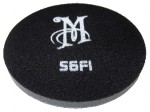 When machine sanding, an interface pad is placed between the sanding disc and backing plate. Its job is to allow the sanding disc to flex, so that it can contour to curved or oddly shaped surfaces. Of course, if a sanding disc features a stiff backing, it will not flex as readily as a sanding disc featuring a soft backing.
When machine sanding, an interface pad is placed between the sanding disc and backing plate. Its job is to allow the sanding disc to flex, so that it can contour to curved or oddly shaped surfaces. Of course, if a sanding disc features a stiff backing, it will not flex as readily as a sanding disc featuring a soft backing.
Although some folks reckon that an interface pad automatically lessens the ability of a disc to level a surface flat or true , this is not always the case. To envision this, first imagine a sanding disc with a very stiff backing (such as a piece of plate aluminum). Without an ability to flex, an interface pad would not improve the contouring ability of the disc. On the flip side, a very pliable sanding disc will respond well to the implementation of an interface pad.
Interface pads are available in a variety of diameters and heights. It is important to note that an interface pad may affect the motion created by the machine via absorption, or cushioning. It therefore makes sense to assume that a tall or pliable interface pad will affect machine motion to a greater degree than a short or stiff interface pad of a similar type. The cushioning of machine motion is especially noticeable when the machine features a very small stroke diameter (a 3/32″ diameter stroke or smaller).
Interface pads can also help to distribute applied pressure and weight across the face of the disc, resulting in a more consistent sanding result.
Fortunately, interface pads are inexpensive, so having a few on hand doesn’t require a big investment.
To learn more, visit the interface pads page.
